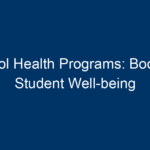In today’s competitive academic landscape, the rising costs of education can be a significant barrier for many aspiring students. However, scholarships have emerged as a powerful tool that can help alleviate this financial burden. These awards provide not just monetary assistance, but also a pathway to realize educational dreams. In this article, we will delve into the various types of scholarships, their benefits, tips on how to apply, and the transformative impact they have on students’ lives.
Understanding Scholarships
What Are Scholarships?
Scholarships are financial grants awarded to students based on various criteria, including academic achievement, financial need, or specific talents. Unlike loans, scholarships do not require repayment, making them a highly sought-after form of financial aid. By understanding the different types of scholarships available, students can better navigate their options and secure funding for their education.
Types of Scholarships
Scholarships can be categorized in several ways. Below are some of the most common types:
-
Merit-Based Scholarships: These are awarded to students based on their academic, artistic, or athletic achievements. Examples include academic scholarships awarded by universities or private organizations.
-
Need-Based Scholarships: These scholarships are aimed at students who demonstrate financial need. They are often provided by governmental bodies, universities, and private organizations.
-
Talent-Based Scholarships: Designed for students with exceptional skills in areas like music, art, or sports, these scholarships recognize talent over academic grades.
-
Demographic-Based Scholarships: These scholarships are specifically designed for students from underrepresented backgrounds or ethnic groups. They include awards for women, minorities, and first-generation college students.
- Field of Study Scholarships: Some scholarships cater to students pursuing specific majors or career paths, such as STEM fields, humanities, or education.
The Benefits of Scholarships
Financial Relief
Perhaps the most immediate benefit of scholarships is the financial aid they provide. By reducing tuition costs, scholarships make higher education more accessible, opening doors for students who may not afford it otherwise. This financial relief allows students to focus more on their studies rather than worrying about student loans and debt.
Enhanced Educational Opportunities
Scholarships often encourage students to pursue higher education in fields they are passionate about, rather than defaulting to less expensive options. With fewer financial constraints, students can explore programs and institutions that align with their career goals.
Networking Opportunities
Scholarship programs often provide additional resources, including networking opportunities with professionals in the field of study. Some scholarships offer mentorship programs, internships, and workshops, further enhancing the educational experience.
Improved Employment Prospects
Many scholarship programs are backed by employers or industry organizations. Receiving a scholarship often enhances a student’s resume, making them more attractive to potential employers. Additionally, some scholarships may offer job placements upon graduation.
How to Find Scholarships
Online Research
Today, a wealth of information is available online. Websites such as Fastweb, Cappex, and the College Board allow students to search for scholarships based on their individual profiles. These platforms aggregate numerous scholarships, helping students find opportunities that align with their backgrounds and aspirations.
School Counseling
High school and college counselors play a crucial role in guiding students towards available scholarships. They often have updated information about local scholarships and can offer insights into application processes.
Community Organizations
Local businesses, foundations, and non-profits frequently offer scholarships to students in their community. Engaging with community organizations can provide access to less competitive, valuable scholarship opportunities.
Social Media and Networking
Many scholarship opportunities are shared via social media platforms. Students should follow educational organizations and influencers in their field to stay updated on new scholarships.
How to Apply for Scholarships
Organizing Your Documents
Before applying, students should prepare essential documents such as transcripts, letters of recommendation, and personal statements. Keeping these organized will streamline the application process.
Tailoring Applications
Each scholarship has specific requirements, so it is vital to read the application guidelines carefully. Tailoring your application materials, including essays and personal statements, to reflect the criteria of each scholarship can significantly improve your chances of success.
Applying Early
Deadlines vary widely, so submitting applications early is advantageous. This not only prevents last-minute stress but also allows for any necessary revisions or additional documentation.
Following Up
After submitting an application, it’s a good practice to follow up with the scholarship committee. This shows your genuine interest and keeps you on their radar.
Overcoming Challenges
Common Misconceptions about Scholarships
One of the biggest misconceptions is that scholarships are only for “top” students. Many scholarships cater to a wide range of applicants, including those with average grades who demonstrate potential and passion. Another myth is that scholarships are only for full-time students. Part-time students can also access many scholarships.
Dealing with Rejections
Not every application will be successful, and that’s okay. Rejections are a part of the process. Students should use feedback, if available, to improve future applications and not be discouraged but instead persist in their search.
Impact of Scholarships on Students’ Lives
The ripple effects of receiving a scholarship go beyond simply alleviating financial stress. Many students report an increase in self-esteem and confidence, knowing that their talents and hard work have been recognized. Additionally, scholarships often encourage students to give back; many scholarship recipients become mentors or provide community support, creating a cycle of opportunity.
Conclusion
Scholarships are more than just financial assistance; they are a pathway to education that empowers students to reach their goals. By understanding the different types of scholarships, utilizing available resources, and presenting strong applications, students can unlock opportunities that might otherwise be out of reach.
As you embark on your educational journey, remember to explore all scholarship avenues. With determination and the right resources, you can overcome financial barriers and achieve your dreams. Take charge of your future today—research, apply, and let scholarships help you pave the way to success!




